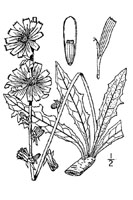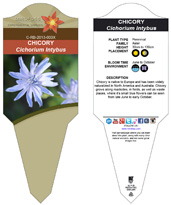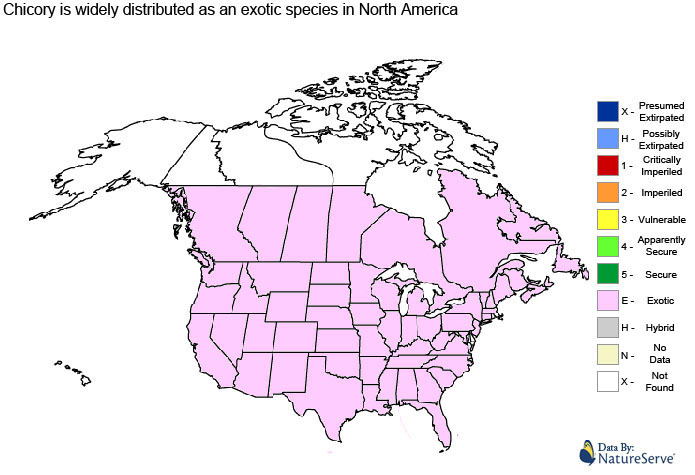
Chicory, Cichorium intybus, is a perennial herbaceous plant usually found with bright blue, rarely white or pink, flowers. Many varieties of chicory are cultivated for salad leaves as well as the root of the plant. Chicory roots, once baked and ground, can be used as a substitute to coffee. Wild chicory leaves are usually bitter. Their bitterness is appreciated in certain cuisines, such as in certain regions of Italy and also in Spain, Greece, and in Turkey. In Albania the leaves are used as a spinach substitute, mainly served simmered and marinated in olive oil, or as ingredient for fillings of byrek. "Chicory" is also the common name in the United States for curly endive, Cichorium endivia; these two closely related species are often confused. The chicory plant is one of the earliest cited plant species in recorded literature including unani system of medicine. The cultivated chicory plant has a history reaching back to ancient Egyptian time. Medieval monks raised the plants and when coffee was introduced to Europe, the Dutch thought that chicory made a lively addition to the bean drink. In 1766, Frederick the Great banned the importatation of coffee into Prussia leading to the development of a coffee-substitute by Brunswick innkeeper Christian Gottlieb Förster (????-1801) who gained a concession in 1769 to manufacture it in Brunswick and Berlin. By 1795 there were twenty two to twenty four factories of this type in Brunswick. Chicory was also adopted as a coffee substitute by Confederate soldiers during the American Civil War, and has become common in the United States. It was also used in the United Kingdom during the Second World War, where Camp Coffee, a coffee and chicory essence, has been on sale since 1885.
Chicory is used as a flavour additive in certain styles of coffee. Chicory is also used as a forage crop for livestock and horses.
Within the realm of rational and holistic medicine, chicory can be used as a bitter digestive tonic. Drinking chicory on a regular basis helps to rid the body of excess water and uric acid buildup without depleting potassium and other minerals, helping to support the liver and the heart. This also makes chicory a good beverage for those with rheumatism and gout.
Please note that MIROFOSS does not suggest in any way that plants should be used in place of proper medical and psychological care. This information is provided here as a reference only.
Chicory is considered edible. The chicory plant has a somewhat bitter taste which can be partially removed by changing the water the plant is boiling in.
The stems of the chicory plant are somewhat woody with flower heads that are 2cm to 4cm wide. Chicory reproduces only by seeds and the pollen of the chicory plant is spread by insects. Chicory seeds do not have any feathery hairs, pappus, but do have toothed scales on top. Chicory is considered a weed in many North American jurisdictions. When flowering, chicory has a tough, grooved, and more or less hairy stem, from 30cm to 130cm tall.
| Plant Height |
30cm to 130cm |
| Habitat |
Fields, Roadsides, Waste places |
| Leaves |
Lanceolate |
|
| Leaf Margin |
Lobate |
| Leaf Venation |
Longitudinal |
| Stems |
Smooth Stems |
| Flowering Season |
June to October |
| Flower Type |
Medium sized ray flowers |
| Flower Colour |
Blue |
| Pollination |
Bees, Self Fertile |
| Flower Gender |
lowers are hermaphrodite and the plants are self-fertile |
| Fruit |
toothed scales |
| USDA Zone |
3A (-37.3°C to -39.9°C) cold weather limit |
No known health risks have been associated with chicory. However ingestion of naturally occurring plants without proper identification is not recommended.
 |
-Click here- or on the thumbnail image to see an artist rendering, from The United States Department of Agriculture, of chicory. (This image will open in a new browser tab) |
 |
-Click here- or on the thumbnail image to see a magnified view, from The United States Department of Agriculture, of the seeds created by chicory for propagation. (This image will open in a new browser tab) |
Chicory can be referenced in certain current and historical texts under the following twelve names although; the naming synanims of chicory may be valid names for different types of plants and may not be in at all related to chicory:
Chicory can be translated into the following select languages:
| Arabic |
الهندبا البرية |
Bulgarian |
цикория |
Chinese (Sim) |
菊苣根 |
| Croatian |
cikorija |
Czech |
cikorka |
Danish |
cikorie |
| Dutch |
cichorei |
Esperanto |
cikorio |
Estonian |
sigur |
| Finnish |
sikuri |
French |
chicorée |
German |
Chicoree |
| Greek |
ραδίκι |
Hebrew |
עולש |
Hungarian |
cikória |
| Italian |
cicoria |
Japanese |
チコリ |
Korean |
치코 리 |
| Low Saxon |
|
Lithuanian |
cikorija |
Norwegian |
sikori |
| Persian |
کاسنی تلخ |
Polish |
cykoria |
Portuguese |
chicória |
| Romanian |
cicoare |
Russian |
цикорий |
Slovak |
čakanka |
| Spanish |
achicoria |
Swedish |
cikoria |
Tagalog |
tsikori |
| Turkish |
hindiba |
Ukrainian |
цикорій |
Vietnamese |
rau diếp xoăn |
| The information provided in this conservation assessment has been provided by the Natureserve Database in conjunction with various federal, provincial, state, county, district, regional, and municipal governments as well as public and private conservation authorities. Information in this section is accurate from the last time this article was updated. |
 |
Chicory has no conservation status as it is considered an exotic and or invasive species in North America. |
 |
The MIROFOSS database offers free printable garden tags for personal and non-profit use. These tags can be used to properly identify plant samples in a garden. Click on the tags shown on the the screen or -click here- to download a full size jpeg image for a chicory identification tag; which can be printed on paper or used with a plastic laser printer. |
 |
What's this?
This is a QR code (short for Quick Response) which gives fast-track access to MIROFOSS articles. QR Codes are barcodes that can be read by smart phone cameras. This QR Code is unique to this MIROFOSS article.
What can I do with it?
You can copy and print the QR code to a plant label, poster, book, web site, magazines, or newspaper so smart phone users can scan the QR Code which automatically takes them to this specific article. |

| Description |
John Cardina, Cathy Herms, Tim Koch, and Ted Webster. "Chickory Cichorium intybus". Ohio Perennial & Biennial Weed Guide. Ohio State University OARDC Extension.
|
| Description |
Rose, Francis (1981). The Wild Flower Key. Frederick Warne & Co. pp. 390–391. ISBN 0-7232-2419-6. |
| Folklore |
Edible and Medicinal Plants of the West, Gregory L. Tilford, ISBN 0-87842-359-1 |
| Biology |
Madrigal L. Sangronis E. "Inulin and derivates as key ingredients in functional foods. |
| Biology |
Elitto, L.; Schacht, W. (1995). Hardy Herbaceous Perennials: A-K ; Vol. 2, L-Z. Timber Press. p. 629. ISBN 978-0-88192-159-5. |
| Image Rendering |
USDA-NRCS PLANTS Database / USDA NRCS. Wetland flora: Field office illustrated guide to plant species. USDA Natural Resources Conservation Service. |
| Environment |
National Audubon Society. Field Guide To Wildflowers (Eastern Region): Alfred A. Knopf. pp 415-420 ISBN 0-375-40232-2 |
| Physical Identification |
National Audubon Society. Field Guide To Wildflowers (Eastern Region): Alfred A. Knopf. pp 415-420 ISBN 0-375-40232-2 |
| April 03, 2015 |
The last time this page was updated |
| ©2021 MIROFOSS™ Foundation |
 |
|
|



















